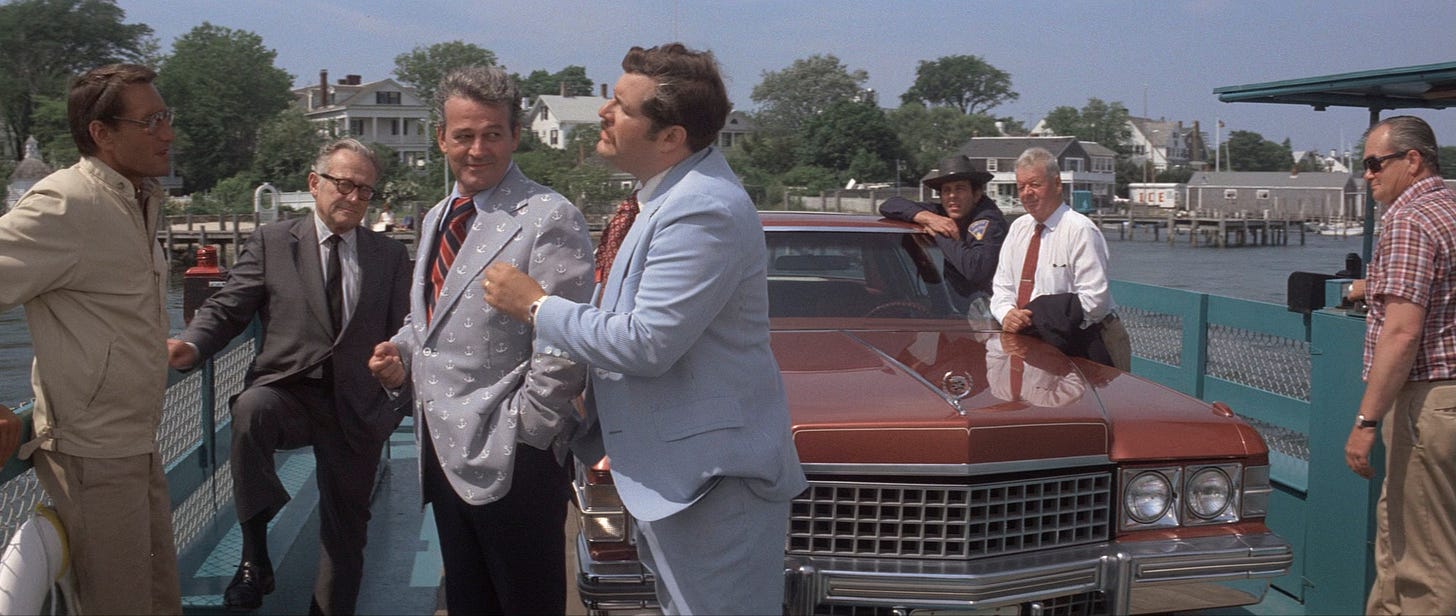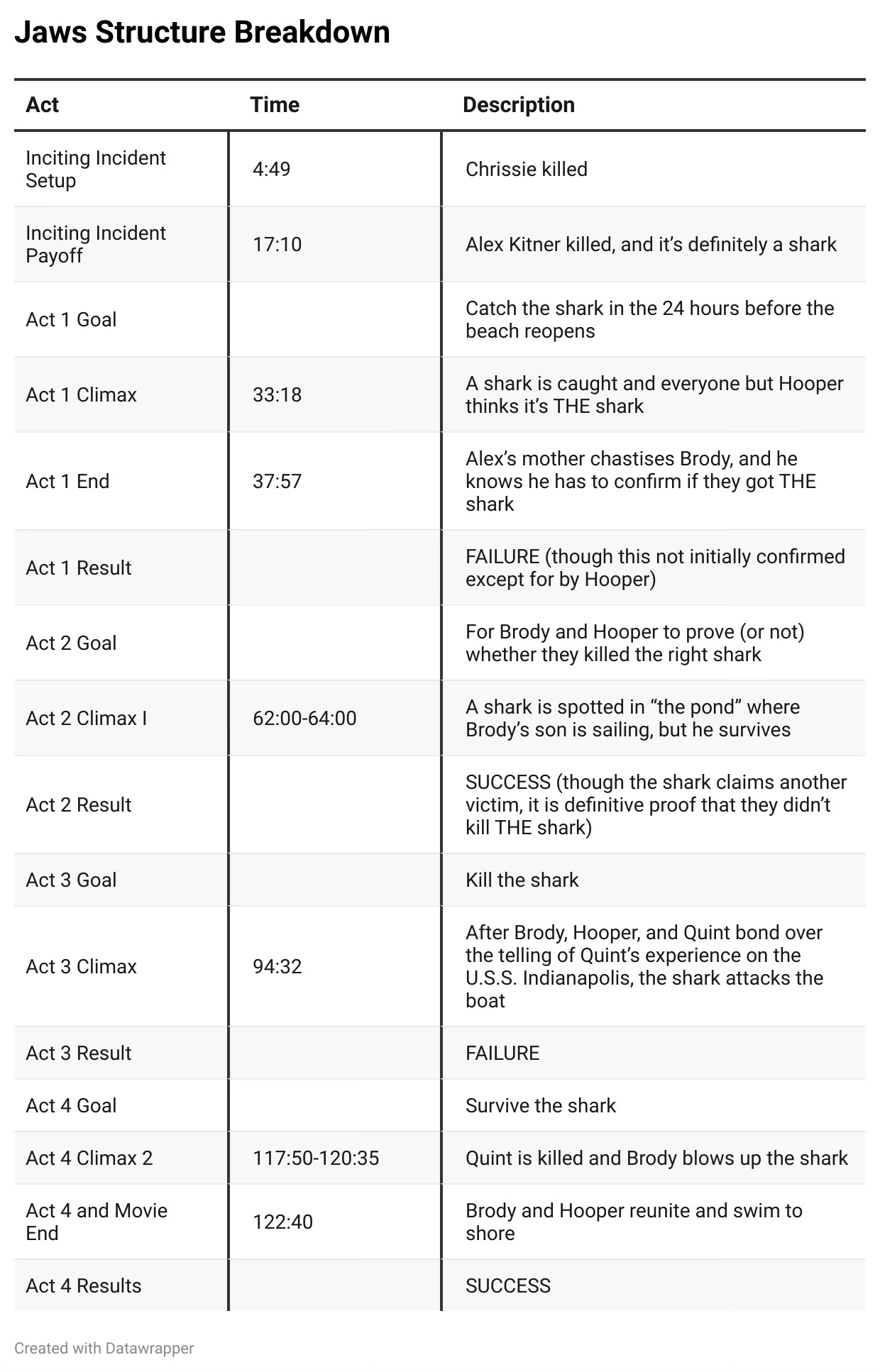Jaws Structure Breakdown
It seemed only fitting that during the 50th anniversary summer of the release of Steven Spielberg’s blockbuster defining Jaws, that the guys at Reel Therapy (formerly 241 Studios) and I analyzed and discussed the movie that changed both the industry itself, as well as our relationship with sharks. It’s a masterclass in filmmaking, and it was a joy to discuss. So checkout the podcast and see my breakdown below!
As always, these breakdowns contain SPOILERS, and are only recommended if you've already seen the movie. You can check my introduction to these breakdowns, to get an overview of my process and philosophy.
Feel free to let me know what you think in the comments below!
The Basics
Director: Steven Spielberg
Writer: Screenplay by Peter Benchley and Carl Gottlieb, based upon the novel by Peter Benchley
Release Date: 1975
Runtime: 124 Minutes
IMDB: https://www.imdb.com/title/tt0073195/?ref_=ttfc_ov_bk
Movie Level Goals
Protagonist: Sherriff Brody
External Movie Level Goal: Survive the shark
SUCCESS | FAILURE | MIXED
Internal Movie Level Goal : None
Goal Relationship: Even though the movie establishes that Brody is afraid of water, he overcomes that fear pretty quickly and easily once he hires Quint and never really has to do anything specific to overcome his fear.
Three Observations
Observation #1: The Two Act 1 Goals
Act I has a unique structure that I haven’t seen too often. It starts with the fact that the Inciting Incident has a Setup and Payoff structure. That, in itself, is not especially unusual. Inciting incidents often come in parts, with a set-up that introduces the possibility of the full Inciting Incident, and then the payoff where the full Inciting Incident comes to pass. From here, the protagonist often then forms a short Act 1 goal that drives the rest of the action until the Act 1 Climax, or the protagonist spends time figuring out how to respond to the Inciting Incident, and is usually forced to do so by the Act 1 Climax.
What makes the Act 1 structure of Jaws so interesting is that our protagonist, Sheriff Brody forms goals both to the Inciting Incident Setup and the Inciting Incident Payoff. The setup comes up pretty early, around the 5-minute mark when Chrissie is killed. The next day Brodie investigates, finds the body, and is told shortly afterward that Chrissie has been killed by a shark. However, when the mayor objects to Brody closing the beaches, the medical examiner recants his cause of death, and Brody, is left with the question of what killed Chrissie (of course the audience knows exactly what killed her). From the 5-minute mark until the Payoff at the 17-minute mark, when Alex is definitively killed by a shark, Brody’s goal is convince the mayor and town to close the beach. He fails at this goal, which leads to the Inciting Incident Payoff—Alex’s death. At that point the mayor agrees to a 24-hour closure of the beaches in an attempt to capture the shark. Though Brody is not an activate participant in trying to kill the shark, his broad goal is to lead the effort to kill the shark in a safe and responsible manner (which coincides with the arrival of Hooper). Of course, a shark is killed and Brody initially celebrates what seems to be the successful completion of his goal until Hooper tells him they haven’t killed the right shark, and Alex’s mother castigates him for keeping the beach open. At that point, Brody realizes he has to keep working to either prove or disprove whether the shark is the right one or not, which leads us into Act 2.
Observation #2: The Internal Goal That Wasn’t
As I’ve discussed in other breakdowns (see Back to the Future and Ferris Bueller), it has become common in the past 25-30 years for most protagonists to have both external and internal goals, and for those goals to be interdependent on each other (that is the protagonist must accomplish one in order to accomplish the other). In movies from the 80’s and earlier, this seems to have been less common (though not totally uncommon either), with protagonists having more simple external goals that are not related to an internal goal. Often in older films, when there is a second goal, it’s often a romantic one that functions similarly to an internal goal, but without the need for the character to make a change or confront an internal conflict.
In some movies from the 80’s and earlier it almost feels as if filmmakers sensed the need to give protagonists an internal conflict, but never seemed to quite tie this to the external goal. This is true in Back to the Future, where Marty is scared to show his music to a record producer out of fear he won’t like it, but that fear is never really developed or plays a part in his success or failures later in the movie.
The same seems to happen in Jaws. Early in the movie, Sheriff Brody is setup with a great internal conflict—he is afraid of water. This is quite clever as he has taken a job on an island, and of course, his main external goal and conflict will be to try to kill and survive the attacks of a great white shark, which causes him to spend the second half of the movie entirely on a boat. Despite this great setup, Brody’s fear of water, while present in the background, never really manifests in any meaningful way in the plot itself. Once Act 3 starts and Brody hires Quint to kill the shark (with the assistance of Hooper), Brody’s fear of water largely evaporates. He’s obviously tentative and inexperienced on the boat. But overall, he functions just fine, and the movie never really foregrounds his fear of water at all. And in the final Act, where today we might see Brody really have to confront his fear of water in order to kill the shark, instead Brody just acts courageously, not really thinking about his fear, as the boat sinks and he tries one last desperate attempt to kill the shark. The final confrontation is clever as Brody clings to the mast and must try to shoot and blow-up the oxygen tank before he sinks into the water. However, as the boat slowly sinks and he fires his rifle, he never seems especially afraid of sinking into the water. In the end, this fear doesn’t really impact his actions, and the movie’s structure is built around the external goal only.
Observation #3: The Subtle Shift from Act 3 to Act 4
Act (and sequence) goals are interesting, because while they provide structure, they are often organic aspects of the plot, and many writers don’t consciously use them to create structure. This can lead to a wide variety of interesting goal set-ups and relationships between goals. But even so, goals still end up providing key structural moments. The Act 3 and 4 goals of Jaws are interesting in this regard. As Act 3 starts, the goal is obvious—to kill the shark. A broad or cursory look at the movie would seem to indicate that this goal never changes through the rest of the movie, and therefore it almost seems as if Act 3 lasts the final 60 minutes of the movie, with no fourth act.
However, a closer look reveals a subtle but important shift in goals that does give us a structure, and therefore a fourth act. The goal of killing the shark in Act 3 is largely a failure, the shark follows the chum trail that they create, and they fire multiple barrels into the shark but are unable to wear it down or stop it. At the end of the day, the shark gets aways, and Brody, Quint, and Hooper rest in the cabin, and eventually bond over comparing scars (Quint and Hooper) and then listening in rapt attention to Quint tell the story of surviving the sinking of the U.S.S. Indianapolis. This moment is important as the three very different men, are finally able to bond. However, immediately after this memorable moment, a key event takes place—the shark attacks the boat. Up until this moment the shark has largely behaved in normal shark fashion—chasing the boat for the chum, then trying to escape when they harpoon the barrels into it. But when it attacks the boat, we have a clear shift in intention from the shark—it is now after Brody, Quint, and Hooper, behaving in an unexpected way, and going from a scary, but natural phenomenon, to almost something supernatural.
Once the shark attacks, things take a downward turn, the engine burns out, and eventually the boat begins to sink. While technically, the three men still want to kill the shark, their primary goal is now survival. If they could escape without killing the shark, they would gladly do so (though killing it is definitely one way to survive it). The one exception is Quint. While Brody and Hooper simply want to survive, Quint’s past experience and his obsession and hatred of sharks, drive him to want to kill the shark at all costs. This conflict in goals between Brody/Hooper and Quint helps provide the excitement of Act 4. But in terms of structure, this subtle shift for Brody of wanting to simply survive is a key change that marks the start of the final act. Of course, in the end, the Act 3 and 4 goals converge, and the only way to survive the shark is to kill it. And unless a sequel were planned, this is really the only logical ending since if they survive without killing it, Amity Island would still be under threat.










